
EC project "Review of Historical Seismicity
in Europe" (RHISE) 1989-1993

|
[Deliverables and queries] [Presentation] [Homepage] |
Introduction
In the afternoon of January 25th, 1348, a serious
earthquake occurred. The epicentral area was believed to be located in the
Austrian town Villach and parts of the Dobratsch mountain slid into the valley.
Estimates of the number of people killed ranged from 5,000 to 10,000. This
might be the information on this earthquake, if you summarise the numerous
but heterogenic reports on that earthquake published since the event. The
various studies on that earthquake have been written from different viewpoints:
the seismological, historical, and philosophical aspect, the aspect of a
natural catastrophe, etc.
Fig. 1 shows the assessment of its parameters
according to five studies selected among those published between 1940 and
1985.
Fig. 2 and Fig. 3 show two macroseismic maps
of the 1348 event as emerging respectively from Ambraseys (1976) and Gentile
et al. (1985). The fact that these two maps differ even in the near-field
area, the differences in epicentral intensity, magnitude and epicentre location
(Fig. 1) suggested the necessity of a re-consideration of this earthquake
from the point of view of historical investigation. So the 1348 earthquake
had been extensively studied as a case history (Hammerl, 1992) to process
the historical source material in the best possible manner employing the
science of history, its auxiliary sciences and subsidiary branches, as well
as by means of special, interdisciplinary methods.
A complete documentation of the sources and
a precise description of the procedure should make this study transparent
for any subsequent studies, which may be geared to other specific tasks,
such as questions on seismicity posed by engineers (building of large technical
constructions, etc.).
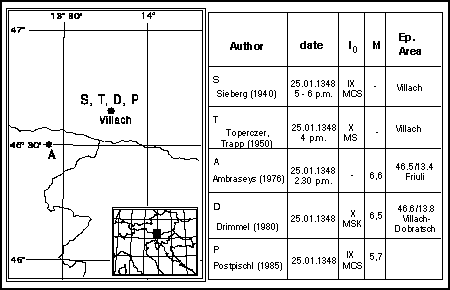
|
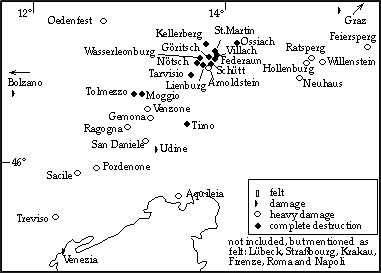
|
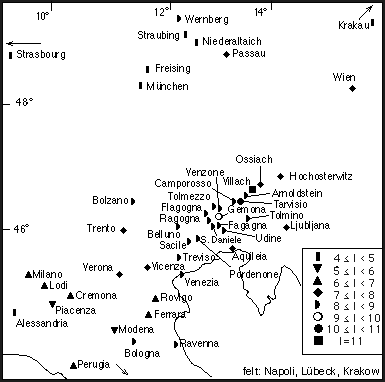
|
Sources and their interdependencies
To get an impression for which localities one
could expect information on earthquake effects ñ and for this purpose
only ñ I studied the far-field of the May 6, 1976 Friuli earthquake.
Therefore, the sources produced in those localities contained in an area
enclosed in a circle wider than the far-field area of the 1976 earthquake
were investigated to find information on the 1348 earthquake.
More than two hundred contemporary sources were
investigated; among them 110 contained information concerning this earthquake.
Fig. 4 shows the place of origin of each source, containing or not records
on the earthquake of 1348. Most of the sources are annals and chronicles
which, for this period, are in most cases edited and more or less easily
available. Archival documents were investigated for the area of Carinthia.
Why did the news of this earthquake spread so
far? What is the reason that so much was written about this earthquake, when
only a small number of sources state that the earthquake has been actually
felt? This last point is important for the evaluation. The fact that the
earthquake is reported, must not lead to conclude that the earthquake was
truly felt in that locality.
As will be shown at the end of this paper, north
of Villach the earthquake was felt in nine places only. In spite of this,
many sources have their origin north of Villach, i.e. the news of the earthquake
spread there more widely than in the southern regions.
The significance of this ascertainment lies
in the fact that previous studies on this earthquake do not often differentiate
between the places where the sources originated and those where it was
"actually felt". When studies on the earthquake (e.g. Ambraseys, 1976;
Karnik et al., 1957) state Lübeck as the northernmost boundary of the
felt area, this is not only incorrect in itself, but all parameters based
on it might also be quantificated incorrectly.

|
If Fig. 5 is consulted to answer the question
why the news of this earthquake spread so widely in the northern region,
the map suggests some reasons for assuming that the spreading of the news
is mostly related to the distribution of monastic communities. With the exception
of some locations, in all places of origin of the sources there were monasteries.
The news of the earthquake spread in particular
throughout the Benedictine and Cistercian orders. The former was probably
informed due to the damage to the Benedictine monastery in Arnoldstein, which
was reported by travelling monks. The reason why Cistercian monasteries were
so well informed even in the far north (Oliva, near Danzig) was probably
due to the annual general chapter held in France, so that the abbots had
detailed information on special events, and entered this information into
their annals and chronicles in their own words.
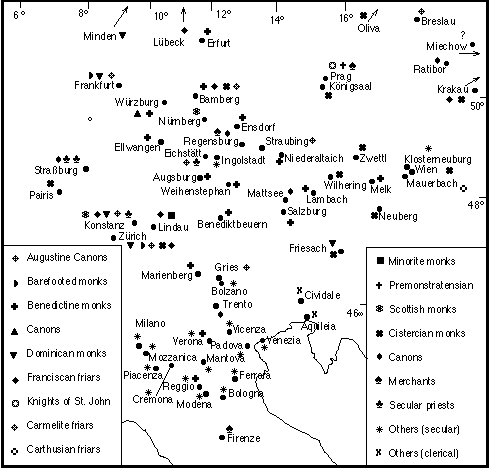
|
It is doubtful whether the earthquake was actually
felt at the Benedictine abbey of Weihenstephan (near Augsburg); more likely
the source constitutes a free interpretation of information supplied by the
brothers at Arnoldstein. A similar account is found in the writings of Albertus
Argentinensis (XIV); he might have learned of the earthquake from the Benedictine
monks in Würzburg or from bishop Berthold of Strasbourg, who was well
informed.
It is very unlikely that the earthquake was
felt in Erfurt. Were the monks of the Benedictine abbey Saint Peter influenced
by news from Arnoldstein? Only the Cronicae S. Petri Erford. Cont. II (XIVa)
speaks of a great earthquake in Erfurt, probably a confusion with another
earthquake or a deformed information about the 1348 earthquake. The Cronicae
S. Petri Erford. Additamentum (XIVc) only contains a general remark, whereas
the Cronicae S. Petri Erford. Cont. III (XIVb) talks of Aquileia. The
Benedictines at Ellwangen (Chronicon Elwacense, XV) mention destructions
in the Friuli area. The Benedictine monk Goswin of Marienberg (XIV) noticed,
among other catastrophes, the destruction of castles, fortresses and cities
in Carinthia. Summarising, one can say that the sources from Benedictine
monasteries are neither identical, nor do they contain similarities. This
leads to the conclusion that the news were not carried from one Benedictine
monastery to the next, but spread throughout the monastic communities.
A detailed study of the Cistercians should be
started at Friesach. Friesach is the Cistercian settlement closest to the
epicentre of the earthquake as assessed by the above mentioned studies. The
second "closest" Cistercian monastery was at Neuberg, the chronicle of which
focused on Villach as the centre of destruction. Like the Dominicans at Friesach
(Annales Frisacenses Continuatio, XIV) (the news of the earthquake originate
at the Dominican monastery), the Cistercians at Zwettl (Annales Zwetlenses,
XIV) also mention destroyed fortresses, in addition to damage in Carinthia,
Styria and Carniola. The Cistercian Benessii de Weitmil (XIV) reports of
Villach and destroyed fortresses, but giving his text an apocalyptic setting.
The Cistercian monasteries of Pairis (Annales Parisienses, XIV) and Oliva
(Chronica Olivensis, XIV) also knew of Villach and destroyed castles and
fortresses. A certain connection becomes apparent in the Cistercian records;
perhaps the abbots were indeed informed of the natural catastrophe at their
annual convention already mentioned.
Although the Dominican monk Heinrich von Herford
(XIV) lived at Minden, far away from the most damaged area, he reported several
facts about the earthquake. He states to have taken this information from
a letter to the provincial prior of the German province. Anonymus Leobiensis
(XIV) had fairly accurate knowledge of the damage in Carinthia. Could it
be that the information of this anonymous author was derived from the Dominican
monastery at Leoben? The Dominicans at Friesach also reported the effects
of the earthquake in Carinthia, as they had felt it themselves. A common
characteristic in Dominican sources is, above all, the relatively good
information on the effects the earthquake had in Carinthia.
In comparison, the places of origin of sources
south of Villach are mostly secular in nature. In the Italian regions, the
news were spread mostly by travelling merchants who were eyewitnesses of
the earthquake. The secular chroniclers probably obtained the information
from them, and in addition, many of the chroniclers had experienced the
earthquake in their own towns, as most reports of damage and of the fact
that the earthquake had been felt come from the regions south of Villach.
Discussion of the main sources
The best report on earthquake effects in Villach
was given by the priest Andreas von Regensburg (1380-1438), who quoted eyewitness
reports of merchants from Regensburg and Prague. The names of the eyewitnesses
are documented, namely Heinreich der Sterner and Hainreich Pawnburger, merchants
from Regensburg, and Stockner, a merchant from Prague. They themselves survived
the earthquake, whereas their four journeymen died. Andreas von Regensburg
(XIV) reports that
"the earthquake was so intense that Villach
was destroyed, including the walls of the fortress, the monastery and church(es)
and that, with the exception of 11 merlons, all walls and towers collapsed.
In the middle of the town the earth split open and water stinking of sulphur
broke forth which flowed off again. In Carniola and Carinthia, the fortress
Kellerberg, the monastery Arnoldstein and 36 other castles were destroyed.
There were landslides and the dammed up water devastated an area of more
than ten miles. The earthquake lasted for 8 days and created crevasses deep
enough to swallow a man up to his belt".
It is not the place here to quote all the sources
examined for the town of Villach; but studying the surviving sources written
within 50 years after the earthquake, published by Wiessner (1968), it appears
that the "ordinary life in a medieval town" was not consequently
influenced by the earthquake; that means that the town of Villach was neither
destroyed completely nor that the earthquake caused heavy damage.
The chronicle written by Giovanni Villani (XIV)
was continued by his brother Matteo until 1363; the entire report is an original
account. Before quoting a letter of some Florentine merchants, Giovanni Villani
himself writes that terrible earthquakes of varying intensity had occurred
in Italy, in Pisa, Bologna and Padua, but particularly in Venice, in which
innumerable stacks or chimneys collapsed, also several church towers and
many houses. To Giovanni Villani, who himself became a victim to the plague
in the summer of 1348, the earthquake was an apocalyptic omen, because he
says that the earthquake meant disaster and pestilence for the places concerned.
He goes on to say "...that in that night it was also dangerous in Friuli,
Aquileia and large parts of Germany...".
I do not want to attribute too much value to
his general statements on damage in Pisa, Bologna, Padua, Venice and Aquileia,
as Villani seems to have obtained this information only from hearsay and
included it for the sake of completeness:
"... That is how it was, and the events were
so bad that one would not believe them, if they were reported orally or in
writing. [To show] that we tell
the truth and not lies, we enclose [in our report] the copy of a
letter which some credible merchants from Florence sent from there. We stick
closely to their testimonies, which they laid down in writing in Udine in
February 1347" Villani writes on.
The description of damage in the letter of the
Florentine merchants, dated February 1347 (Florentine calendar!), is very
valuable, as they were eyewitnesses of the earthquake. These merchants certainly
saw some of the damage they mentioned themselves or heard about it from other
merchants who were also on the great trade route from Austria to Italy, via
St. Veit (on the Glan river), Feldkirchen and Villach (Fig. 6).
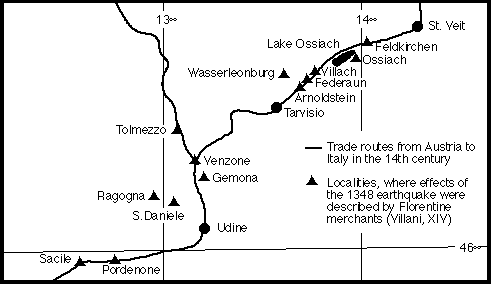
|
However, Villani does not state where the Florentine
merchants were at the time of the earthquake. They describe the effects of
the earthquake in the places along this trade route in the following order:
Sacile, San Daniele, Ragogna, Gemona, Venzone, Tolmezzo, Wasserleonburg,
Federaun, Villach, Arnoldstein, Ossiach and Feldkirchen. It is interesting
that the merchants, like Villani, keep referring to divine omens and finally
the Last Judgement, which corresponds with the interpretation of natural
phenomena at that time.
Another very detailed description of the effects
in this area is given in the contemporary history of Bertrand, the patriarch
of Aquileia (Nicoletti, XIV). His description of damage in Venice, Villach,
Federaun and Arnoldstein is more detailed, of the earthquake effects in Friuli
more general, as he mentions damage to Udine, Cividale, Gemona, Tolmin and
Flagogna in one breath. The great damage to the church of Aquileia is mentioned
in particular, as this is, of course, of great importance to him:
"Ö Ma fra gli orrendi guasti che questo
flagello meno nella Provincia nostra il maggiore toccò alla Chiesa
d'Aquileja, la quale fu in tal modo rovinata da far meraviglia e dolore
all'intero Friuli."
Information on damage east to north-east of
Gemona is almost exclusively found in the Gesta Bertholdi (Mathias von Neuenburg,
XIVa, b). It is difficult to say exactly why the bishop of Strasbourg had
such exact information on this area. One assumption is that he, being Grand
Master of the Teutonic Order, was informed by the members of the order in
Friesach, another that he obtained his information because of his connections
to the Habsburgs.
The Gesta reports that the following castles
and settlements were destroyed: Waldenstein, Liemberg, Reifnitz, Wildenstein,
Krainburg, Osterberg, Wallenberg, Wasserleonburg, Ortenburg and Rosegg.
Ortenburg, Wasserleonburg, Osterberg and Federaun are also mentioned by Detmar
(XIV), the Franciscan from Lübeck; however, he started his chronicle
only in 1385 and obtained his information from other chronicles, reports,
etc. Among other sources, Detmar probably also used the Gesta Bertholdi by
Mathias von Neuenburg (XIVa) as a reference. Detmar lists partly distorted
names for a series of destroyed castles, so that not all of them can be
identified. The destruction of Ortenburg castle, the ancestral seat of the
Earl of Ortenburg, is also mentioned in the Bozner Chronik (XIV).
Villani and the Florentine merchants only named
Wasserleonburg, Federaun, Arnoldstein, Ossiach and Feldkirchen in that area.
Was that because these sites were the closest ones to the trade route?
It is interesting to note that Kellerberg Castle
is mentioned in two totally different sources, i.e. by Andreas von Regensburg
(XIV), who quotes merchants from Regensburg and Prague, and by the Anonymus
Leobiensis (XIV). The merchants quoted by Andreas von Regensburg mention
Villach and Arnoldstein, perhaps also because these places are situated along
the trade route (Fig. 6). Why Anonymus Leobiensis particularly mentions
Kellerberg, Hollenburg, Arnoldstein and Villach is not quite clear.
Other places mentioned by several contemporary
sources are Udine (3 sources), Aquileia (4 sources), Venice (4 sources) and
Padua (4 sources).
Giovanni da Parma (XIV), canon at Trient, only
heard about damage in Udine: "Even worse news are told by people coming
from abroad: half of the palace of Udine, which belongs to the patriarch
of Aquileia, has collapsed...". Nicoletti (XIV) mentions damage in Udine
in one breath with that in other places. Yet the Florentine merchants' account
of the collapse of the patriarchal palace and some other houses is credible,
as they spent some time in Udine.
The damage to the church of Aquileia is mentioned
by Belloni (XIV): he reports a testimony by Gubertino, who - as secretary
to the patriarch of Aquileia - should know about it in detail ("At postquam
Basilicam Aquilejensem terrae tremor dejeceratÖ"); the Florentine
merchants ("Ö it was also dangerous in Friuli, Aquileja during this
nightÖ"); the history of the patriarch of Aquileia (Nicoletti, XIV)
("Öil maggiore [guasto] toccò alla Chiesa d'Aquileja,
la quale fu in tal modo rovinata da far meraviglia e dolore all'intero
Friuli"). The Cron. S. Petri Erford. (Additamentum, XIVc) reports on
Aquileia only in general terms ("Quedam insignis civitas nomine Aquileja
penitus deleta est et absorbita per predictum terre motum") and, of course,
can have obtained the information only by hearsay. Anyway, damage to the
basilica is well documented.
In his introduction, Villani mentions strong
shocks in Venice, but does not go into details, i.e. he only had second-hand
information on it. The history of the patriarch of Aquileia lists the damaged
parts in detail, probably from correspondence among the patriarchs ("Ö
In Venezia oltre molti edifizi pubblici e privati, precipitarono i campanili
di S. Silvestro, di S. Giacomo dall'Orio e di S. Vitale, cosi la cima della
Chiesa di S. Angelo e la parte manca della Chiesa di S. BasilioÖ").
A Franciscan chronicle of Bologna (Corpus chronicorum Bononiensium, XIV),
which was written before 1394, also mentions a great earthquake in Venice,
but probably drew on various other sources for information ("Ö e
grandissimo fu in quell'ora in Venezia, e gran novità ivi furono nelle
case, e in Messere San Marco, che' è la lor Chiesa
principaleÖ"). The following inscription can still be seen on the
former Scuola della Carità (Venezia e la Peste, 1978):
"In nome de Dio eterno e de la Biada Vergene
Maria. In l'ano de la Incarnacion del nostro signor miser iesu Christo MCCCXLVII
a dì XXV de çener lo dì de la conversion de Sen Polo,
cerca ora de vespero fo gran taramoto in Veniexia e quasi per tuto el mondo
e caçe molte cime de campanili e case e camini e la glesia de Sen
Baseio, e fo sì gran spavento che quaxi tuta la çente pensava
di morir, e non stete, la tera de tremar cerca dì XL; e può
driedo questo començà una gran
mortalitadeÖ".
In Villani's introduction, great shocks are also mentioned to have occurred in Padua; his message is not very detailed. The contemporary Liber Regiminum Padue (XIV) does not report damage in Padua; it only mentions an earthquake on that day. The Chronicon Patavinum (XIV) only mentions a great earthquake all over the world. The chronicle by Guglielmo Cortusi (XIV) for the period 1237-1358, but written in the years 1315 to 1358, reports in contemporary style:
"The Almighty God, who does not want the
sinner to die, but to convert and stay alive, first threatens and then strikes
mankind with incredible, with unheard of blows, he started His horrifying
judgement first at the (mankind) in order to better and not to destroy it.
As it was His will to strike outer end of the world, in the East. But after
having struck the Tartars, the Turks and all of the tribes of the infidels,
a great earthquake of half an hour occurred in 1348, on the 25th of January,
at 11 p.m. to the horror of the Christians."
In conclusion, no damage at Padua can be deduced
from these sources.
Effects in other localities are mentioned by
a minor number of sources. The Notae Veronenses (XIV), written by an inhabitant
of Verona, mention a strong earthquake in Verona, however, in February, on
St. Paul's Day (not expressly St. Paul's Conversion, which can lead to mistakes).
This section is followed by the ominous conjunction of the planets Mars and
Jupiter.
Approximately 20 years after the earthquake,
the Italian humanist, philologist and poet, Francesco Petrarca (XIV), in
a letter dedicated to the archbishop of Genoa, wrote:
"Ö I was sitting in my library, at Verona
at that time, and although I was not totally unfamiliar with this matter,
I was highly bewildered by the sudden and new occurrences. The floor was
trembling under my feet, and when, from all sides, the books bumped one another
and fell down, I was shocked, hurried from the room and saw the servants
and soon also other people running to and fro with fright. There was deathly
pallor on all faces."
Summarising, these reports do not mention any
damage in Verona.
Giovanni da Parma (XIV) reports as follows about
the earthquake in Trient:
"Be it known to all who want to hear it that
in the year 1348 after the birth of the Lord, there was a slight earthquake
in the first indication, around vespers time on January 25, that is on the
festival of the Conversion of Saint Paul, followed almost without interruption
by a second one of such magnitude, that the campanile of S. Maria was swaying
to and fro from the shocks, so that the bells hanging on it started to ring
on their own account, and the water truly spattered from the baptismal fonts.
The earthquake lasted so long that one could have easily said slowly three
'Lord's Prayers and three 'Hail Mary's".
This source seems to be the reliable testimony
of an eyewitness. Interesting in this connection is the fact that for instance
Mariani (1673), who wrote his account 300 years later using the chronicle
by Giovanni da Parma, had the campanile of S. Maria collapse, which had only
swayed in da Parma's account. Such distortion of information in the course
of time is a well-known phenomenon; later accounts always have to be examined
very carefully.
The Chronicon Estense (XIV) was continued by
contemporaries in Ferrara from 1340 to 1354, who noted a strong earthquake
in it. The contemporary report by the Dominican Bartolomeo da Ferrara (XIV)
is based on the Chronicon Estense. Thus one can say that the earthquake was
strongly felt in Ferrara, but that there was no damage.
In his Rhymed chronicle, Bonamente Aliprandi
(XIV), doctor of law from Mantua (d. 1417), briefly mentions the earthquake,
which caused no damage, so you can infer that the earthquake caused no major
damage in Mantua, but you cannot necessarily conclude that it did not cause
minor damage. In this case the lower limit ought to be interpreted as
"earthquake felt", the upper one with "slight damage". The
gap between "felt" and "slight damage" may comprise up to three
ratings on the intensity scale.
Villani mentions Bologna in his introduction
only, which, as said above, has little value. A Franciscan chronicle of Bologna
(Corpus chronicorum Bononiensium, XIV) speaks in general terms of a strong
earthquake which, after all, could also refer to Bologna. Only Cherubino
Ghirardacci (1596-1657), in his Historia of Bologna, mentions damage:
"... it was such a great earthquake that
it frightened the whole town of Bologna, then towards the Square and the
Galleria Street many houses collapsed and some palaces and towers started
to move due to the severe vibration
...".
As the Franciscan chronicle does not report
damage, in my opinion the earthquake was merely felt in Bologna.
Pisa is the southernmost town mentioned, and
in Villani's introduction only. This information is somewhat doubtful.
The Annales Cremonenses (Cavitelli, 1588) state
"Ö earth shocks could be felt, through which in Cremona, where Otto
de Bonis was praetor; in Lodi, Milano and Venice houses collapsed". This
is the only source I have on Cremona, Lodi, and Milano: at least, one can
conclude that the earthquake was felt there.
In Mozzanica, a small locality south-east of
Milano, an eyewitness wrote the following note (ASMi, XIV):
"In the year 1348 / on the 25th day of January,
Friday / at vespers time the earth trembles mightily / towers and houses
all over the world are trembling / people fell down dazed with fear. I, Giovanni
de Lene, wrote the stated poetical verses from my own experience with my
own hand at the moment when the earth
trembled."
Although these lines have been written in a
poetical form, nevertheless one can assume that the earthquake was really
felt there.
Both the physician Giovanni Agazzari (XV), born
1413 in Piacenza, in his Chronica Civitatis Placentiae, and Iohannes de Mussis,
also from Piacenza, in his Chronicon Placentinum (XIV) (original from 1375
onwards), state in the very same words that the earthquake was felt in Piacenza.
Agazzari could have borrowed this information from de Mussis.
Finally, the sources do not contain reliable
data on the number of people killed by the 1348 event, even if they repeatedly
speak of very many dead.
Conclusions
Fig. 7 and 8 show the effect distribution of
the earthquake, in which the more reliable data, assessed from the critically
examined sources, were taken into account for the individual localities.

|
Most of the previous studies on this earthquake,
such as those mentioned in the introduction, located the epicentral area
in Villach. There is abundance of information on the earthquake of 1348.
Unfortunately there is a minor number of sources with regard to Villach and
its vicinity, compared with the long list of texts mentioning the earthquake
in a merely general context.
It is interesting in this context that 40 percent
of the more than 100 sources reporting on this earthquake ñ and examined
for the case study ñ mention the town of Villach and its vicinity.
With all these describing a catastrophe in this town and its surroundings,
it is still worth questioning why the remaining 60% of the sources do not.
The reason for stressing such heavy damage in Villach in the studies written
centuries later after the earthquake could be that the authors were fascinated
by the impressive mountain slide of the Dobratsch close to Villach and in
the following period they would have overestimated the sources concerning
Villach and the mountain slide and wrong interpretations of the sources
increased.
In Fig. 7 and Fig. 8 one can see, that using
contemporary sources heavy damage is concentrated in the Friuli area and
damage is reported in some localities in the South of Carinthia, the Northwest
of Slovenia and in the Northeast of Italy. The earthquake of January 25th,
1348 was probably felt from Bologna in the south, Milan in the west, Osterberg
in the east and Friesach in the north.
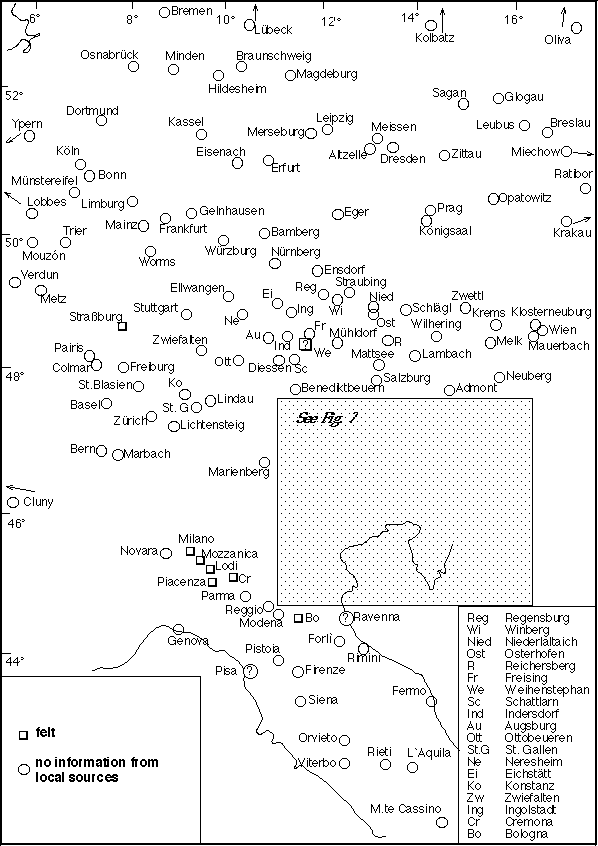
|
Acknowledgements
This paper is based on the case study "Das Erdbeben
vom 25. Jänner 1348 ñ Rekonstruktion des Naturereignisses" (Hammerl,
1992), which was partly financially supported by the Austrian Science Foundation
under the project P6868 "Historische Seismizität in Mitteleuropa" and
by the Austrian Academy of Science. This support is greatly appreciated.
The author would like to thank P. Albini and
M. Stucchi for the critical and fruitful discussion.
References
Agazzari, G., XV. Chronica Civitatis Placentiae.
In: A. Bonora (Editor), 1862, Monumenta Historica ad Provincias Parmensem
et Placentinam Pertinentia, Parma, 3, pp. 1-76.
Albertus Argentinensis, XIV. In: J. Rasch
(Editor), 1591. Erdbidem Chronic nach art eines Calenders, sambt einem kurtzen
bericht und Catalogo Autorum. Darin allerley Erdbiden vnd Erdklüfften,
vor Christi Geburt 1569 und sovil deren biß auf diß 1591 jars
her beschrieben, München.
Aliprandi, B., XIV. Aliprandina o Cronica
de Mantua. In: O. Begani (Editor), 1908-1910, RIS/2, Città di Castello,
24/13, pp. 21-180.
Ambraseys, N.N., 1976. The Gemona di Friuli
earthquake of 6 May 1976. In: P. Pichard, N.N. Ambraseys, G.N. Ziogas, 1976.
The Gemona di Friuli earthquake of 6 may 1976. UNESCO, Restricted Technical
report RP/1976-76, Paris, II, pp. 1-111.
Andreas von Regensburg, XIV. Sämtliche
Werke. In: G. Leidinger (Editor), 1903, Quellen und Erörterungen zur
bayerischen und deutschen Geschichte, München, N.S., 1, pp.
LXV-LXVI.
Annales Frisacenses Continuatio, XIV. In:
L. Weiland (Editor), 1879, MGH, Script. rer. Germ., Hannover, 24, p.
67.
Annales Parisienses, XIV. In: A. Bernoulli
(Editor), 1890. Basler Chroniken, Historische und Antiquarische Gesellschaft
in Basel, Leipzig , 4, pp. 376-380.
Annales Zwetlenses, XIV. In: W. Wattenbach
(Editor), 1851, MGH, Script. rer. Germ., Hannover, 9, p. 685-689.
Anonymus Leobiensis (deutsche Fortsetzung
des), XIV. In: H. Pez (Editor), 1721, Scriptores rerum Austriacarum, Leipzig,
1, coll. 755-968.
ASMi (Archivio di Stato di Milano), XIV.
Fondo Statuti, cartella M-Z: Statuti di Mozzanica del 1303 (con aggiunte
posteriori).
Bartolomeo da Ferrara, XIV. Polyhistoria
Fratris Bartholomaei Ferrariensis Ordinis Praedicatorum ab Anno MCCLXXXVIII
usque ad annum MCCCLXVIII. In: L. A. Muratori (Editor), 1738, RIS, Milano,
24, coll. 806-808.
Belloni, A., XIV. Vitae Patriarcharum
Aquilejensium. In: L. A. Muratori (Editor), 1730, RIS, Milano, 16, coll.
23-70.
Benessii de Weitmil, XIV. Chronicon. In:
J. Emler (Editor),1884, Fontes Rerum Bohemicarum, Praha, 4, pp.
457-548.
Bozner Chronik, XIV. Universitäts
Bibliothek, Innsbruck, ms. 502, fol. 29, 30.
Cavitelli, L., 1588. Annales Cremonenses.
Cremona.
Chronica Olivensis, XIV. In: W. Ketrzynski
(Editor), 1893, Monumenta Poloniae historica, Krakau, Ser.1, 6, pp.
310-350.
Chronicon Elwacense, XV. In: A. Abel (Editor),
1852, MGH, Script. rer. Germ., Hannover 10, p. 34-51.
Chronicon Estense, XIV. In: L. A. Muratori
(Editor), 1729, RIS, Milano, 15, coll. 299-534.
Chronicon Patavinum ab anno Christi 1174
usque ad 1399, XIV. L. A. Muratori (Editor), 1741, Antiquitates Italicae
Medii Aevi, Milano, 4, coll. 1119-1168.
Corpus chronicorum Bononiensium, XIV. In:
A. Sorbelli (Editor), 1910-1938, RIS/2, Bologna, 18/1, vol. 2.
Cortusiis, G. de, XIV. Chronica de Novitatibus
Paduae et Lombardiae. In: L. A. Muratori (Editor), 1728, RIS, Milano, 12,
coll. 926-927.
Cronicae S. Petri Erfordensis, XIVa, b, c.
In: O. Holder-Egger (Editor), 1899. a) Cont. II; b) Cont. III; c) Additamentum.
MGH, Script. rer. Germ., Hannover, 42, pp. 150-398.
de Mussis, I., XIV. Chronicon Placentinum.
In: L. A. Muratori (Editor), 1730, RIS, Milano, 16, coll. 448-560.
Detmar, XIV. Chronik. In: K. Koppmann (Editor),
1884. Die Chroniken der deutschen Städte. Leipzig, 19/1, pp.
121-186.
Drimmel, J., 1980. Rezente Seismizität
und Seismotektonik des Ostalpenraumes. Der Geologische Aufbau Österreichs,
Wien.
Gentile, F., Renner, G., Riggio, A.M., Slejko,
D. and Zacchigna, M., 1985. The Villach earthquake of January 25, 1348. In:
D. Postpischl (Editor), Atlas of isoseismal maps of Italian earthquakes.
Quad. Ric. Scient. 114, 2A, Bologna, pp. 14-15.
Ghirardacci, C., 1596ñ1657. La Historia
di Bologna. Bologna.
Giovanni da Parma, XIV. Cronaca inedita.
In: A. Pezzana (Editor), 1837. Storia della Città di Parma, Parma,
1.
Goswin, von Marienberg, XIV. Chronik des
Stiftes Marienberg. In: B. Schwitzer (Editor), 1880, Tiroler Geschichtsquellen,
Innsbruck , 2, p. 135.
Hammerl, Ch., 1992. Das Erdbeben vom 25.
Jänner 1348 ñ Rekonstruktion des Naturereignisses. Diss. Univ.
Wien, Vienna, 256 pp.
Heinrich von Herford, XIV. A. Potthast (Editor),
1859. Liber de rebus et temporibus memorabilioribus,
Göttingen.
Karnik, V., Michal, E. and Molnar, A., 1957.
Erdbebenkatalog der Tschechoslowakei bis zum Jahre 1956, Práce
Geofysikálního Ústavu Ceskoslovenské Akademie
Ved, 69, Sborník.
Liber Regiminum Padue, XIV. In: A. Bonardi
(Editor), 1905-1908, RIS/2, Città di Castello, 8/1, pp.
268-376.
Mariani, M., 1673. Trento con il sacro concilio,
ed altre notabili. Aggiunte varie cose miscellanee universali. Trento.
Mathias von Neuenburg, XIVa. Gesta Bertholdi
Episcopi Argentinensis. In: A. Hofmeister (Editor), 1924-1940, MGH, Script.
rer. Germ., Berlin, N.S., 4, pp. 532-534.
Mathias von Neuenburg, XI b. Chronik. A.
Hofmeister (Editor), 1924-1940, MGH, Script. rer. Germ., Berlin, N.S., 4,
pp. 262-263.
Nicoletti, Patr. di Bertrando, XIV. In: F.
Manzano (Editor), 1865. Annali del Friuli, ossia raccolta delle cose storiche
appartenentia questa regione, Udine , V, p. 55.
Notae Veronenses, XIV. In: C. Cipolla (Editor),
1890. Antiche Cronache Veronesi. Monumenti storici pubblicati dalla Deputazione
Veneta di Storia Patria, Ser. III, 2, p. 475.
Petrarca, F., XIV. Rerum senilium, lib. X,
ep. II. Francisci Petrarchae Florentini Operae quae extant. Basilea
1581.
Postpischl, D. (Editor), 1985. Catalogo dei
terremoti italiani dall'anno 1000 al 1980. Quad. Ric. Scient., 114, 2B,
Bologna.
Sieberg, A., 1940. Beiträge zum
Erdbebenkatalog Deutschlands und angrenzender Gebiete für die Jahre
58 bis 1799. Mitteilungen des Deutschen Reichs-Erdbebendienstes, H. 2,
Berlin.
Toperczer, M. and Trapp, E., 1950. Ein Beitrag
zur Erdbebengeographie Österreichs. Mitteilungen der Erdbeben-Kommission,
N.F., 65,Wien.
Venezia e la Peste 1348ñ1797, 1978.
Exhibition catalogue. Venezia.
Villani, G., XIV. Cronaca. In: F. G. Dragomanni
(Editor), 1845, Collezione di Storici e Cronisti Italiani editi e inediti,
Firenze, 4, pp. 183-185.
Wiessner, H. (Editor), 1968. Monumenta historica
ducatus Carinthiae. Die Kärntner Geschichtsquellen 1335ñ1414.
Klagenfurt.
[Top]
[Vol.1]
[Vol.2]
[Deliverables and queries]
[Presentation]
[Homepage]